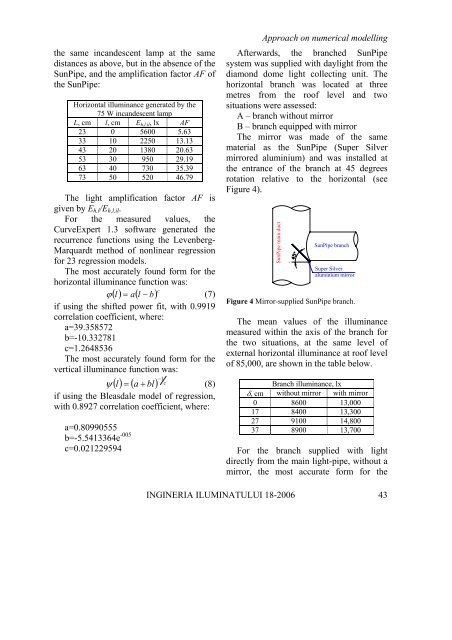This issue is sponsored by the Philips Romania, Lighting Division
This issue is sponsored by the Philips Romania, Lighting Division
This issue is sponsored by the Philips Romania, Lighting Division
Create successful ePaper yourself
Turn your PDF publications into a flip-book with our unique Google optimized e-Paper software.
<strong>the</strong> same incandescent lamp at <strong>the</strong> same<br />
d<strong>is</strong>tances as above, but in <strong>the</strong> absence of <strong>the</strong><br />
SunPipe, and <strong>the</strong> amplification factor AF of<br />
<strong>the</strong> SunPipe:<br />
Horizontal illuminance generated <strong>by</strong> <strong>the</strong><br />
75 W incandescent lamp<br />
L, cm l, cm Eh,l,il, lx AF<br />
23 0 5600 5.63<br />
33 10 2250 13.13<br />
43 20 1380 20.63<br />
53 30 950 29.19<br />
63 40 730 35.39<br />
73 50 520 46.79<br />
The light amplification factor AF <strong>is</strong><br />
given <strong>by</strong> Eh,l/Eh,l,il.<br />
For <strong>the</strong> measured values, <strong>the</strong><br />
CurveExpert 1.3 software generated <strong>the</strong><br />
recurrence functions using <strong>the</strong> Levenberg-<br />
Marquardt method of nonlinear regression<br />
for 23 regression models.<br />
The most accurately found form for <strong>the</strong><br />
horizontal illuminance function was:<br />
() ( ) c<br />
ϕ l = a l − b<br />
(7)<br />
if using <strong>the</strong> shifted power fit, with 0.9919<br />
correlation coefficient, where:<br />
a=39.358572<br />
b=-10.332781<br />
c=1.2648536<br />
The most accurately found form for <strong>the</strong><br />
vertical illuminance function was:<br />
() ( ) c<br />
−1<br />
ψ l = a + bl<br />
(8)<br />
if using <strong>the</strong> Bleasdale model of regression,<br />
with 0.8927 correlation coefficient, where:<br />
a=0.80990555<br />
b=-5.5413364e -005<br />
c=0.021229594<br />
Approach on numerical modelling<br />
Afterwards, <strong>the</strong> branched SunPipe<br />
system was supplied with daylight from <strong>the</strong><br />
diamond dome light collecting unit. The<br />
horizontal branch was located at three<br />
metres from <strong>the</strong> roof level and two<br />
situations were assessed:<br />
A – branch without mirror<br />
B – branch equipped with mirror<br />
The mirror was made of <strong>the</strong> same<br />
material as <strong>the</strong> SunPipe (Super Silver<br />
mirrored aluminium) and was installed at<br />
<strong>the</strong> entrance of <strong>the</strong> branch at 45 degrees<br />
rotation relative to <strong>the</strong> horizontal (see<br />
Figure 4).<br />
SunPipe main duct<br />
SunPipe branch<br />
Super Silver<br />
aluminium mirror<br />
Figure 4 Mirror-supplied SunPipe branch.<br />
The mean values of <strong>the</strong> illuminance<br />
measured within <strong>the</strong> ax<strong>is</strong> of <strong>the</strong> branch for<br />
<strong>the</strong> two situations, at <strong>the</strong> same level of<br />
external horizontal illuminance at roof level<br />
of 85,000, are shown in <strong>the</strong> table below.<br />
Branch illuminance, lx<br />
δ, cm without mirror with mirror<br />
0 8600 13,000<br />
17 8400 13,300<br />
27 9100 14,800<br />
37 8900 13,700<br />
For <strong>the</strong> branch supplied with light<br />
directly from <strong>the</strong> main light-pipe, without a<br />
mirror, <strong>the</strong> most accurate form for <strong>the</strong><br />
INGINERIA ILUMINATULUI 18-2006 43
















